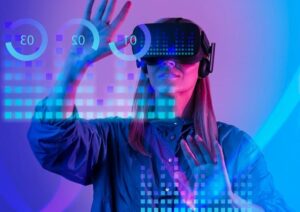Augmented Reality (AR) transcends buzzwords; it’s a transformative tech knitting virtual elements into our daily existence. At its core stands an uncelebrated hero: the “mesh.” But what role does this “mesh” truly play in augmented reality, and why is it so vital?
Unveiling the Role of Mesh in Augmented Reality
In AR, the mesh operates as a digital blueprint, erecting 3D frameworks for virtual realms. Imagine it as the virtual scaffolding molding reality within the digital sphere. How does it achieve this?
This mesh serves as a virtual architect, meticulously crafting 3D representations by fragmenting surfaces into myriad triangles or polygons. Each minute fragment, imbued with color and texture, weaves the fabric of authenticity. But its significance goes beyond aesthetics.
This intricate lattice isn’t just about visual allure; it’s the foundation delineating object placements and spatial dynamics. In essence, the mesh forms the bedrock upon which augmented reality thrives.
The Significance of Mesh Optimization in AR and 3D Modeling
Mesh optimization, a lesser-known but crucial facet, wields its influence by simplifying complex digital 3D models. It delicately prunes vertices and polygons, paring the excess without diluting the model’s essence. But why is this critical?
In the realm of AR, where real-time rendering reigns supreme, this process becomes indispensable. It enhances performance, expediting loading times by trimming the model’s bulk. Think of it as sculpting away the redundant to unveil the masterpiece.
This refined mesh, post-optimization, maintains the 3D object’s integrity while ensuring smoother rendering and efficient operation on AR devices. Moreover, it safeguards precision, crucial for applications like facial recognition.
Reimagine consumer engagement with Augmented Products.
Diverse Applications of Mesh in AR
Mesh’s versatility spans numerous AR applications. From sculpting lifelike 3D models to navigating virtual landscapes, its utility knows no bounds.
Imagine an AR environment responsive to gestures or objects, or a navigation system guiding users through real-world spaces seamlessly—mesh makes these a tangible reality. It’s the secret ingredient behind interactive surfaces and physics-based environments, fostering immersive AR experiences.
Find out more in this video Reality vs Augmented Reality Bracelet
Mesh’s Impact on Augmented Reality
Mesh isn’t a mere bystander; it’s the driving force behind AR’s realism and functionality. Its meticulous mapping of physical spaces and seamless integration of virtual elements elevate user experiences.
From precise tracking to enhanced visuals, mesh bridges the gap between physical and virtual realms. It breathes life into digital replicas of real-world objects, inviting users to explore with depth and clarity.
Advancements in Augmented Reality Empowered by Mesh
As technology progresses, augmented reality evolves, and mesh stands pivotal in this journey. Mesh optimization isn’t just about cutting excess; it’s about enabling AR to soar. By reducing computational demands and refining performance, it unlocks smoother, faster, and more captivating AR experiences.
Mesh: Crafting Immersive Realities
Imagine wandering through an AR-enhanced museum, where mesh crafts intricate replicas of ancient artifacts. Its ability to meld the real and virtual breathes life into history, offering unparalleled educational experiences.
Or envision an AR-powered shopping escapade, where mesh seamlessly integrates virtual furniture into your living room. The precision of mesh mapping ensures flawless alignment, empowering informed purchasing decisions.
Mesh in Collaborative Design
Beyond entertainment, mesh catalyzes change in professional realms. Architects visualize creations within physical spaces using AR-powered models, courtesy of mesh technology. Designers collaborate, refining prototypes in augmented reality, utilizing mesh’s precision for real-world impact.
The Future of Mesh in AR
Augmented reality evolves, and mesh remains at the forefront. Its role transcends visuals; it’s a facilitator blending physical and virtual realms seamlessly. As advancements continue, mesh’s precision will unlock new realms, reshaping interactions and perceptions.
FAQs About Mesh in AR
In AR, the mesh crafts 3D models, forming the foundation for virtual object creation, ensuring a lifelike representation of reality in the digital realm.
Mesh optimization enhances performance by reducing complexity, enabling detailed virtual scenes within AR environments.
Meshes in AR generate, modify 3D models, facilitate navigation systems, and enable immersive gaming experiences.
Conclusion
In the tapestry of augmented reality, mesh emerges as the thread weaving together digital and physical realms. Its impact surpasses visuals; it’s the conduit for immersive experiences. Understanding and harnessing the potential of mesh will shape a future where reality and imagination converge seamlessly.

Average Rating